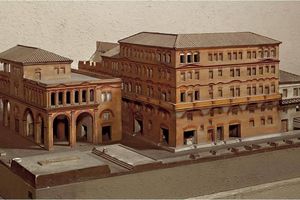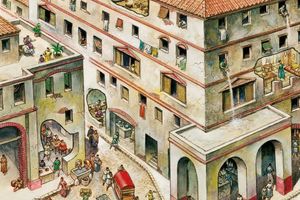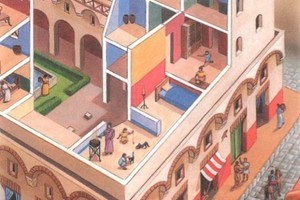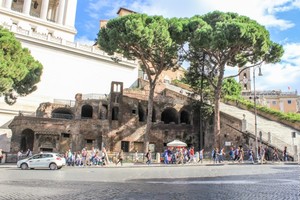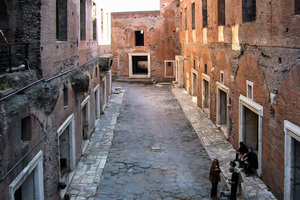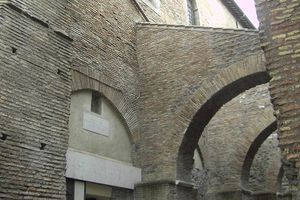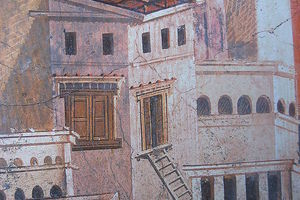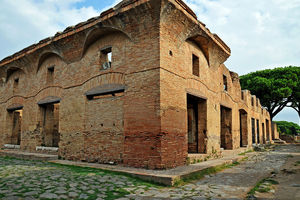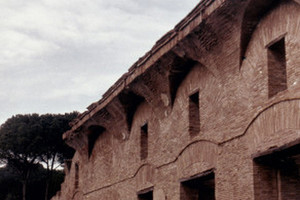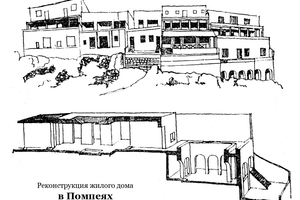Insula
Insula (Latin: insula - island) was a multi-story residential building in ancient Rome where middle-class and poor residents rented housing. Such buildings first appeared in Rome itself and later spread to many other cities of the Empire.
In Rome, the population grew during the Republican era, and there were an increasing number of merchants, craftsmen, and people of various social statuses, many of whom could not afford luxurious homes with an atrium in the city center or beyond the city limits, let alone their own housing. It is worth noting that Rome was constrained in terms of available land: the city center was filled with numerous temples, the houses of wealthy citizens, and later, forums. The scarcity of land in the city led to high prices. Common citizens who worked in the cities settled in income-generating houses called insulae, which had 4-5 floors.
Cicero describes such buildings in Rome, of which there were a great number: "Rome ... rose up and hung in the air" (Cic., De leg.arg.II.35). Over time, insulae were constructed in many Roman cities, such as Pompeii and Ostia. Depending on the population density of a particular city, the price of land, and the social status of tenants, the number of insulae and the number of floors in them varied. The construction of such buildings was carried out by future landlords who rented them out to a single person. Tenants paid rent for their apartments not to the property owner, but to this large tenant who then paid the rent to the landlord. Tenants had the right to arrange their rooms as they saw fit. Insulae were designed for people of different social means, so both the exterior and interior of the buildings varied. Some had certain decorations, while others were completely devoid of them. If the need arose and funds allowed, tenants could enlarge or reduce their apartments. It is important to note that the apartment of a wealthy individual could occupy an entire floor or even two, connected by a staircase. However, this only applied to wealthy tenants, as an average person of moderate means could not afford such luxury and would occupy a small two-room apartment.
People with very low income lived either on the streets or in their own workshops, or in insulae where two or three families shared one apartment, usually located on the upper floors. There was another category of people for whom even a "roof over their heads" was unattainable, and they had to settle in basements and crypts (Sergeenko E.M. Life in Ancient Rome, p. 89).
Insulae had many disadvantages that affected both wealthy and poor residents. Firstly, there was no running water in such buildings, except on the ground floor, and even that was not always the case, as permission to bring water into the building had to be obtained from the authorities, and landlords were often denied permission. Residents of the 2nd to 5th floors had to carry water up the stairs, which were often located on the exterior of the building. There was also no equivalent of modern sewage systems and centralized dumps - waste and garbage were thrown directly out of the window. Roman insulae did not have toilets, although they were present in houses in Ostia. Juvenal wrote about this: "Windows where the vigil is held: from above, broken dishes fly; it's good if they only throw out a large bowl" (Juven., III, 269-277). The buildings had no heating, and tenants had to create something similar to modern braziers in their rooms. Water was heated over a fire in special containers. To retain warmth in the rooms, mica or shutters were inserted into the windows, as glass was very expensive (Sergeenko E.M. Life in Ancient Rome, p. 89).
Another issue with insulae was their often inconvenient layout and the use of cheap construction materials. Property owners sought to save on construction costs like any other entrepreneurs, aiming to maximize profits. As a result, tall buildings were erected on small plots of land with shallow foundations (5-6 meters), leading to numerous collapses. In the future, emperors began to address this issue by enacting laws that limited the height of insulae. The appearance of the first insulae and the invention of cement date back to the 3rd century BCE. This building material is strong when the proportions of its components are observed: rubble (small gravel, broken bricks, clay tiles, marble fragments) mixed with red pozzolana (a special volcanic sand). Red pozzolana was expensive, so it was often replaced with dark gray, which made the cement, and therefore the entire structure, less durable. The floors in insulae were made of wood.
When considering all the aforementioned factors, it becomes apparent that the majority of insulae were constructed from non-durable, highly flammable materials, without centralized water supply or heating systems, and with open flames present in almost every apartment. It is no wonder that Plutarch refers to fires and collapses as the "cohabitants of Rome" in one of his biographies (PL., Crass.2). Let's say a few words about the insulae in the cities of Ostia and Pompeii. The income-generating houses here were similar in layout to those in the capital. Like Roman insulae, they mostly lacked peristyles and faced the street with walls containing small openings for light. Most of the houses in Ostia have been preserved, but only their lower parts, although it is certain that they were multi-story, although lower than those in Rome (Gartman K.O. History of Architecture, Vol.1, p.264).
Now let's turn to the houses of wealthy residents that were excavated in Pompeii. One such house is the House of the Triclinia, with a large open courtyard surrounded by a portico reminiscent of a peristyle. The House of the Muses features a twelve-room apartment on the first floor with frescoes and mosaics created by first-class craftsmen. The House of the Dioscuri is one of the largest and most beautiful insulae in Ostia, featuring an integrated bathhouse (Sergeenko E.M. Life in Ancient Rome, p.77).
The insulae in the city of Pompeii differed from both those in Ostia and the multi-apartment houses in Rome. Pompeii was a provincial city, and there was no need for very tall buildings here. Instead, two-story apartment buildings were constructed, with the first floors made of stone and the second floors made of wood. People of moderate means could afford to allocate the first floor for workshops and use the second floor as living quarters. The upper floors of both Pompeian and Ostian insulae projected slightly over the street (Gartman K.O. History of Architecture, Vol.1, p.265).
In conclusion, it can be noted that today, much like during the time of the Roman Republic, multi-story buildings for people of moderate means are constructed with minimal costs in mind, aiming for maximum height and lacking significant decoration.
Related topics
Literature
1. Hartman K. O.History of Architecture [History Of Architecture].T1. Moscow: Izogiz Publ., 1936-267 p.
2. Decimus Junius Juvenal. Satires. St. Petersburg: Aleteya Publ., 1994-224 p.
3. Marcus Tullius Cicero. Speeches. In 2 volumes. Moscow: Nauka. 1993-444p.
4. Plutarch. Comparative biographies in 2 volumes, Moscow: Nauka Publ., 1961-503 p.
5. Life of Ancient Rome-Sergeenko. pdf
